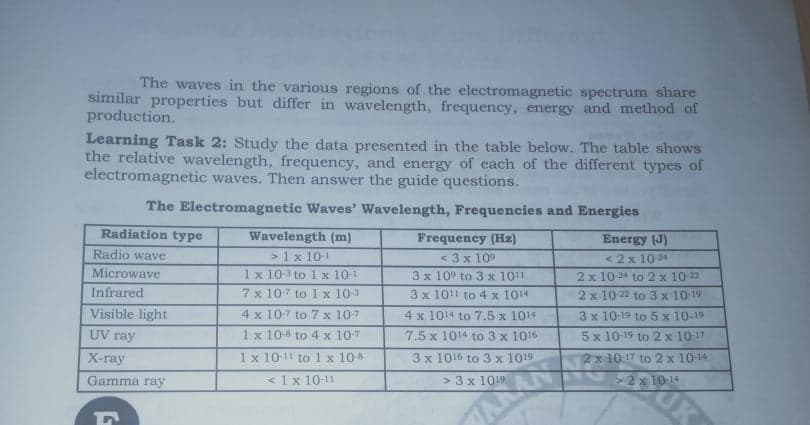The waves in the various regions of the electromagnetic spectrum share properties but differ in wavelength, frequency, energy and method of tion. ng Task 2: Study the data presented in the table below. The table shows ative wavelength, frequency, and energy of each of the different types of nagnetic waves. Then answer the guide questions. The Electromagnetic Waves' Wavelength, Frequencies and Energies Eion type Wavelength (m) > 1 x 101 1 x 103 to 1 x 10-1 7 x 107 to 1 x 103 Frequency (Hz) < 3 x 109 3 x 10° to 3 x 1011 Energy (J) <2 x 1024 ave Rve 2 x 1024 to 2 x 1022 3 x 10 to 4 x 1014 2 x 10-22 to 3 x 10-19
The waves in the various regions of the electromagnetic spectrum share properties but differ in wavelength, frequency, energy and method of tion. ng Task 2: Study the data presented in the table below. The table shows ative wavelength, frequency, and energy of each of the different types of nagnetic waves. Then answer the guide questions. The Electromagnetic Waves' Wavelength, Frequencies and Energies Eion type Wavelength (m) > 1 x 101 1 x 103 to 1 x 10-1 7 x 107 to 1 x 103 Frequency (Hz) < 3 x 109 3 x 10° to 3 x 1011 Energy (J) <2 x 1024 ave Rve 2 x 1024 to 2 x 1022 3 x 10 to 4 x 1014 2 x 10-22 to 3 x 10-19
Chapter8: Electromagnetism And Em Waves
Section: Chapter Questions
Problem 1MIO
Related questions
Question

Transcribed Image Text:The waves in the various regions of the electromagnetic spectrum share
similar properties but differ in wavelength, frequency, energy and method of
production.
Learning Task 2: Study the data presented in the table below. The table shows
the relative wavelength, frequency, and energy of each of the different types of
electromagnetic waves. Then answer the guide questions.
The Electromagnetic Waves' Wavelength, Frequencies and Energies
Radiation type
Wavelength (m)
Frequency (Hz)
Energy (J)
Radio wave
>1 x 10-1
1 x 10-3 to 1 x 10-1
< 3 x 109
Microwave
Infrared
< 2 x 10-24
2 x 1024 to 2 x 10 22
2 x 10-22 to 3 x 10-19
3х 10° to 3 х 101
7x 107 to 1 x 10-3
3 x 10!1 to 4 x 1014
Visible light
4 x 107 to 7 x 10-7
4 x 1014 to 7.5 x 1014
3 x 10-19 to 5 x 10-19
UV ray
1 x 10-8 to 4 x 10-7
7.5 x 1014 to 3 x 1016
5 x 10-19 to 2 x 10-17
X-ray
1x 10-11 to 1 x 10-8
3 x 1016 to 3 x 1019
2x 1017 to 2 x 10-14.
Gamma ray
< 1 x 10-11
> 3 x 1019
> 2 x 10 14

Transcribed Image Text:1. Which EM waves has the largest wavelength?
2. Which EM waves has the shortest wavelength?
3. How will you compare the frequency and energy of the EM waves?
Expert Solution
This question has been solved!
Explore an expertly crafted, step-by-step solution for a thorough understanding of key concepts.
This is a popular solution!
Trending now
This is a popular solution!
Step by step
Solved in 2 steps with 2 images

Knowledge Booster
Learn more about
Need a deep-dive on the concept behind this application? Look no further. Learn more about this topic, physics and related others by exploring similar questions and additional content below.
